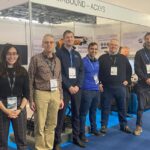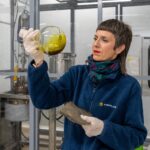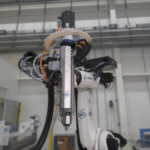The Graphene Flagship, that represents a new form of joint, coordinated research on an unprecedented scale, forming Europe’s biggest ever research initiative, brought together top European researchers and companies to discuss the most disruptive ways graphene could enhance composites used in the aerospace, automotive and energy industries.
The multidisciplinary team involved researchers from academic institutions, business enterprises such as Graphene Flagship Partners Nanesa and Avanzare, and large transportation end-user industries, such as Graphene Flagship Partners Airbus and Fiat. They showed that integrating graphene and related materials (GRMs) into fibre-reinforced composites (FRCs) has great potential to improve weight and strength, and helps to overcome the bottlenecks limiting the applications of these composites in planes, cars, wind turbines and more. Nowadays, the transportation industry is responsible for nearly one-third of global energy demand, and it is the major source of pollution and greenhouse gas emissions in urban areas. Graphene Flagship scientists are therefore continually trying to develop new materials to lower fuel usage and CO2 emissions, helping to mitigate environmental damage and climate change.
The great potential of graphene-integrated composites
Graphene-integrated composites are an example of lighter materials with great potential for use in vehicle frameworks. They are constructed by introducing graphene sheets, a few billionths of a metre thick, into hierarchical fibre composites as a nano-additives. Hierarchical fibre composites are a type of composite material in which components of different sizes are combined in a controlled way to significantly improve mechanical properties. They typically consist of micro- or mesoscopic carbon fibres, a few millionths of a metre thick, attached to a polymer matrix, and they are already used as building materials to make vehicles of all shapes and sizes.
Graphene’s high aspect ratio, high flexibility and mechanical strength enable it to enhance the strength of weak points in these composites, such as at the interface between two different components. Its tunable surface chemistry also means that interactions with the carbon fibre and polymer matrix can be adjusted as needed. The fibre, polymer matrix and graphene layers all work together to distribute mechanical stress, resulting in a material with improved strength and other beneficial properties.
There are many challenges to consider. For instance, planes experience temperature changes between 20 °C and -40°C every time they take off and land, with huge differences in pressure and humidity. Graphene-integrated composites therefore need to withstand water condensing and even freezing inside the fuselage. They also need to endure lightning strikes, which happen several times per month, so the conductive properties of graphene must be harnessed to create an electrically conductive framework that resists electromagnetic impulses. In cars, new structural materials must be able to withstand crash tests and be lightweight enough to ensure fuel efficiency. Graphene Flagship researchers are also investigating conductive materials to replace circuitry in car dashboards.
Researchers and end-users come together
Graphene Flagship partners at Queen Mary University and the National Graphene Institute, UK, FORTH-Hellas, Greece, CNR, Italy, and Chalmers University of Technology, Sweden, collaborated with researchers at the University of Turin, the University of Trento and KET-LAB, Italy, and the University of Patras, Greece, to provide perspectives from the research community. They worked with scientists at Graphene Flagship partner companies Nanesa, Italy, and Avanzare, Spain, to review the technological viability of graphene-incorporated FRCs.
Francesco Bertocchi, co-author of the paper and President of Nanesa, believes that graphene-incorporated FRCs are indeed feasible for vehicle design, and has created new composites with many essential properties for the transportation industries. “Thanks to the Graphene Flagship, Nanesa has worked in close synergy with many partners to create many different prototypes. These include properties such as flame retardancy, water vapor absorption barrier, high electrical and thermal conductivity, EMI shielding. We also integrated thermo-resistive systems for de-icing and anti-icing ,” he says.
Graphene Flagship Partners Airbus and Fiat-Chrysler Automobiles, world leading aerospace and automotive industries, evaluated the impact of graphene-incorporated FRCs on the aerospace and automotive industries and assessed their commercial viability.
Tamara Blanco-Varela, co-author and materials and processes engineer at Airbus, explains that Airbus is working hard to make these materials viable for use in new aircraft models. “We all know that the aeronautical sector is very challenging for the introduction of new materials or technologies. Airbus is committed to making graphene-related materials fly as soon as possible, and a step-by-step approach is being set up,” she says. By selecting ‘quick-win’ applications with immediate benefits to the aerospace industry, she anticipates that graphene-integrated FRCs will reach the market soon.
Brunetto Martorana, co-author and researcher at Graphene Flagship partner Fiat-Chrysler Automobiles, adds: “The structural properties of graphene have opened an interesting window for designing novel light composites.” He explains that new lightweight composite materials do not necessarily need to be lower in strength and introduce safety issues. “New approaches must be found to enhance the ‘crashworthiness’ of composites – and graphene composites may be able to fill that role,” he continues. “Fiat-Chrysler Automobiles have now committed to the commercialization of new composite materials, and will be leading a new initiative to bring this technology to market.”
An uplifting outlook
“The Graphene Flagship provides a stable, clear, long-lasting partnership for different partners to work together. They all started their collaboration as part of our Composites Work Package,” comments Vincenzo Palermo, Graphene Flagship Vice-Director and lead author of the paper. “The Graphene Flagship pushes all partners to have frequent interactions, with regular meetings—like in this case, partners who began working on graphene with different motivations have come together to address common challenges,” he says.
Source: Graphene Flagship ‒ The news is adapted with editorial change by Compositi magazine
Picture on the top: Credit: Airbus












